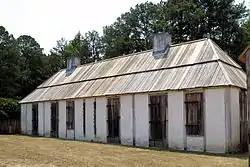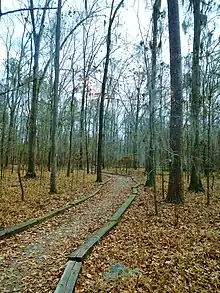Fort Jackson (Alabama)
Fort Toulouse and Fort Jackson are two forts that shared the same site at the fork of the Coosa River and the Tallapoosa River, near Wetumpka, Alabama.
Fort Toulouse Site-Fort Jackson | |
 A portion of the modern Fort Toulouse reconstruction, taken in 2007. | |
  | |
| Nearest city | Wetumpka, Alabama |
|---|---|
| Coordinates | 32°30′12″N 86°15′23″W |
| Built | 1814 |
| NRHP reference No. | 66000148 |
| Significant dates | |
| Added to NRHP | October 15, 1966[1] |
| Designated NHL | October 9, 1960[2] |
Fort Toulouse was a stockade built by the French in 1717. It was replaced by a better-built fort of the same name in 1735, a bit further back from river erosion. Fort Toulouse served as a trading post with the Creek Indians until the end of the French & Indian War in 1763. With the French loss of that conflict, the French garrison spiked their cannons and left for both New Orleans and a return to France. The British victors chose not to occupy the Fort, and it eventually collapsed into decay.
In the midst of the War of 1812, an 1813 civil war in the Creek Nation led to an invasion by Americans from Tennessee, Georgia, and Mississippi Territory. In the ensuing Creek War of 1813-1814, General Andrew Jackson commanded the combined American forces of Tennessee militia, U.S. regulars, and Cherokee and Creek Indian allies. Jackson defeated the Red Stick Creeks at the Battle of Horseshoe Bend in 1814, and afterwards initiated construction of a fort atop the site of the old French fort at the confluence of the Coosa and Tallapoosa rivers. The fort was intentionally built near the sacred Creek site known as the Hickory Ground.[3] Jackson then temporarily traveled to Washington and in his absence, the fort was named "Jackson" in his honor. After Jackson's return, he imposed the Treaty of Fort Jackson upon both the Northern Creek enemies and the Southern Creek allies, wresting 20,000,000 acres (8,100,000 ha) from all Creeks for white settlement.
The site was declared a National Historic Landmark in 1960.[2][4]
During the American Bicentennial in the mid-1970s an attempt was made to reconstruct Fort Toulouse, however the replica was incorrectly built upon the outline of the much larger Fort Jackson.
Fort Toulouse-Fort Jackson State Historic Site

The William Bartram Arboretum is an arboretum located at 2521 Fort Toulouse Road, near Wetumpka, Alabama, in the United States. In the 1980s the park became a property of the Alabama Historical Commission and the incorrectly built fort was dismantled and recycled to partially construct a "correct" replica of Ft. Toulouse adjacent to the original site, allowing for a future reconstruction of Ft. Jackson on the actual site once occupied by both forts.
The Fort Toulouse-Fort Jackson State Historic Site has active "Living History" programs depicting the original Creek Indian inhabitants, the French Colonial Military presence, and the War of 1812 era U.S. Military presence.
It is located southwest of Wetumpka off U.S. Highway 231 (Alabama).
References
- "National Register Information System". National Register of Historic Places. National Park Service. January 23, 2007.
- "Fort Toulouse Site-Fort Jackson". National Historic Landmark summary listing. National Park Service. Archived from the original on 2008-01-11. Retrieved 2007-10-21.
- A. J. Langguth, Union 1812, 2006, p. 287
- Cecil McKithan (June 29, 1989) National Register of Historic Places Inventory-Nomination: Fort Toulouse / Fort Jackson, National Park Service and Accompanying 1 photo, undated.
External links
- Fort Toulouse-Fort Jackson State Historic Site - official site
- Fort Toulouse/Fort Jackson - Alabama Historical Commission
- Fort Toulouse website

